If cinema in Ireland in July 1916 prompts reflection on film as a weapon of war, developments the following month show significant developments in the emergence of film as an expression of national culture. On 7 August 1916, audiences at Dublin’s Bohemian Picture Theatre were the first to see O’Neil of the Glen (often spelled O’Neill of the Glen), the first Film Company of Ireland (FCOI) production to be publicly released. Formed in March 1916 by James Mark Sullivan and Henry Fitzgibbon, the FCOI would become the most important indigenous fiction film producer of the 1910s. Ò’Neil of the Glen itself, however, is believed to be a lost film, like all FCOI’s other production except Knocknagow (1918), Willy Reilly and His Colleen Bawn (1920) and one reel of the two-reel comedy Paying the Rent (1920). Nevertheless, its success with audiences was vital to securing FCOI’s future.
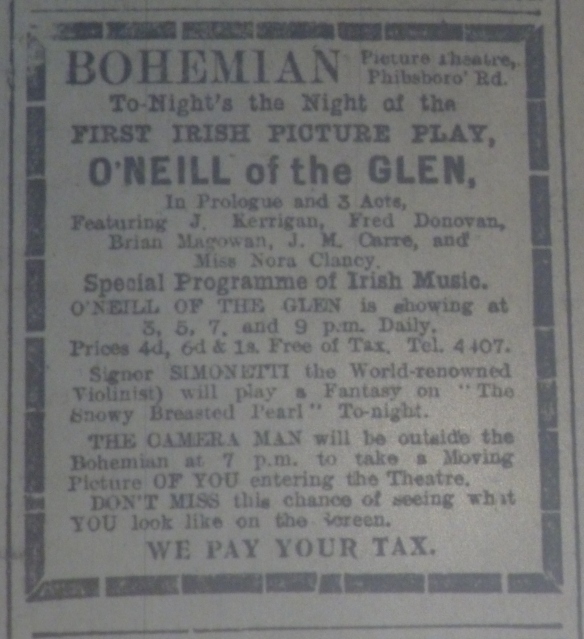
Ad for the first public exhibition of O’Neil of the Glen, at Dublin’s Bohemian, Dublin Evening Mail 7 Aug. 1916: 2.
That success was won in part by the careful management of publicity, a fact that means that the surviving ads, articles and reviews in the press must be treated with caution. It may be a forgivable exaggeration for the papers to have hailed the premiere of O’Neil of the Glen as the start of a new Irish industry, but it was not true that this was “the first picture-play ever produced in Ireland by an Irish company of Irish players,” a claim repeated almost verbatim in several paper, indicating that the journalists were working from the same FCOI publicity materials (“New Irish Industry,” “O’Neill of the Glen,” “Irish Film Triumph”). Most recently, Charles McEvoy of Dublin’s Masterpiece Cinema had funded Fun at Finglas Fair – even if it had allegedly been destroyed during the Easter Rising before being publicly shown – and in 1912-13, cinema-owner and mayor John J. Farrell had made a number of films with his company Irish Film Productions (Rockett 95, Condon 237).
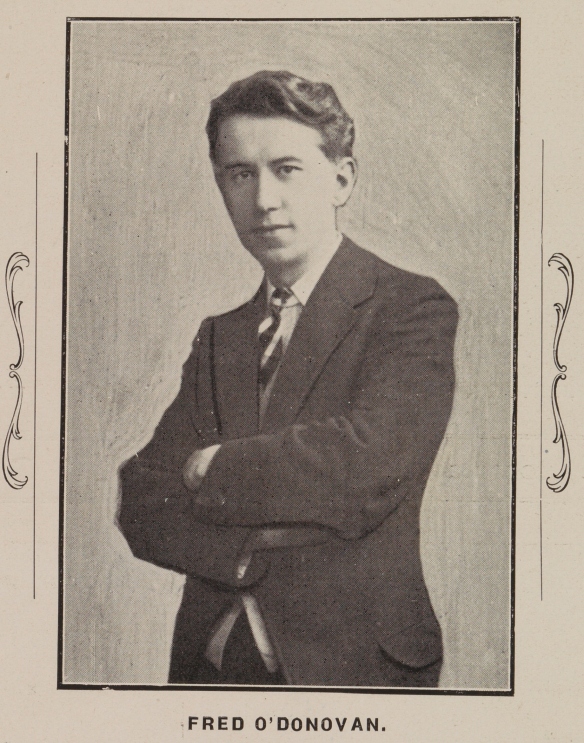
Abbey Theatre and Film Company of Ireland actor – and later director – Fred O’Donovan; Irish Limelight 1:5 (May 1917): 6.
Nevertheless, although O’Neil of the Glen was not the first indigenous Irish fiction film, it was a very significant one by the country’s most important film production company of the 1910s. On 29 June, FCOI announced a “trial exhibition,” or what would now be called a test screening, of their first completed production, O’Neil of the Glen, at Dublin’s Carlton. By this time, and in the context of management difficulties at the Abbey Theatre, FCOI had been able to contract J. M. Kerrigan and Fred O’Donovan, two of the Abbey’s biggest stars, albeit that they were permitted to appear in certain plays (“Abbey Theatre,” “Platform and Stage”). Kerrigan, indeed, directed and played a part in O’Neil of the Glen, a three-reel feature based on a script adapted by W. J. Lysaght from M[argaret] T. Pender’s story of the same title that had been serialized in the Shamrock in 1891. The film told how Don O’Neil (Brian Magowan), the son of a landowner who had been defrauded by the solicitor Tremaine (J. M. Carre), saves the life of Tremaine’s daughter, Nola (Nora Clancy), whose love he wrests from Graves (O’Donovan), a blackmailing suitor (“Bohemian,” Evening Mail).
“The film is of a quality which leads one to anticipate success for the venture,” wrote an Irish Times correspondent at the trial exhibition, noting that it was part of a process of perfecting the film: “the promoters are engaged in a ruthless revision of the film to bring it up to the highest possible standard” (“Irish Film Production”). The Bioscope’s Irish correspondent Paddy’ was less complimentary about this early cut of the film, pointing out that although “[g]reat care was taken with the production and camera work,” it possessed “many of the weak points common to first productions” (“Paddy,” 13 Jul.). Addressing a lunch for the press at the Gresham Hotel after the screening, Fitzgibbon claimed that FCOI “had started an industry which would eventually be a source of great revenue in Ireland.” For his part, Sullivan argued that the film showed that Irish productions – taking advantage of Irish “imagination, ideals, and artistic temperament and beautiful scenery” – could competing with those anywhere (“Irish Film Production”).
Paddy began to revise his lukewarm opinion of O’Neil of the Glen in light of the news that Frederick A. Sparling had booked the film for its first run at his Bohemian for the week of 7-13 August. The Bohemian was one of Dublin’s biggest and most luxurious cinemas, and Sparling’s commitment to a run that was twice the usual three days “speaks well for the film and the undoubted drawing powers such a production will have for Irish audiences” (Paddy, 27 Jul.). In the event, Sparling also included an unplanned Sunday show to take advantage of the phenomenal level of interest.
Although FCOI appears to have taken the bookings itself, prominent local distributor Ben Cowan of Express Film Agency handled this and other FCOI films from 1916 by running trade shows and placing advertisements in the daily and trade press. It was likely one of Cowan’s “novel ideas in the advertising line” for FCOI cameraman John A. Bennett – a former projectionist at Dublin’s Rotunda – to film the audience on the first night and for this local film to be shown subsequently with the feature (Paddy, 27 Jul.; 17 Aug.). “Don’t miss this chance of seeing what you look like on the Screen,” ads warned the opening-night audience. The musical attractions included a special programme of Irish melodies and the cinema’s “world-renowned violinist” Signor Simonetti playing a fantasy on the “Snowy Breasted Pearl” at the evening shows. “It is confidently hoped that large audiences will visit the Bohemian during the coming week,” revealed a preview in the Evening Mail, “and thus mark in a tangible manner their appreciation of what may justly be described as a really first-class picture-play, and one that is sure to bring the work and the players of the Film Company of Ireland right into the forefront of popularity with audiences and trade alike” (“Bohemian”).
The surprising extent of the success of O’Neil of the Glen must be measured in the first instance as a marketing victory rather than an artistic one, by FCOI. The degree to which these early films challenged existing ways of representing the Irish is questionable, but many contemporary commentators seem initially to have been content that films with wholly Irish creative input were finally being made. Nevertheless, the way in which the company were able to capitalize on the interest and goodwill attending the exhibition of this first indigenous Irish fiction film and, crucially, to publicize the large attendances not only in Ireland, where interest was likely to be strong in any case, but also in Britain, appears to have secured a British distribution deal and thereby to have ensured the company survival in this initial period. This success was built on what appears to have been a genuinely surprising level of interest in the picture. “The film, which was expected to prove a good draw, actually surpassed all anticipations,” observed Paddy, warming further to the film, “a record being established for the week, and queues being the rule every evening” (17 Aug.). The Irish Times commented that enthusiastic audiences in a crowded cinema “proves that the Dublin public is always ready to support and encourage Irish enterprise” (“Film Company of Ireland,” 9 Aug.). “That the genuine enthusiasm displayed last night at the conclusion of the film will be the means of bringing before the public a second production by the Irish Film Company in the near future,” observed the Freeman’s Journal, “is a universal wish” (“Bohemian”).
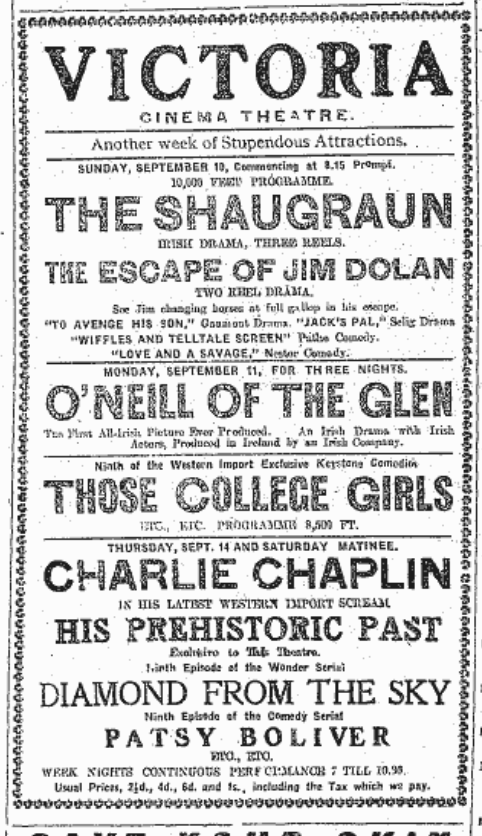
Ad for Galway’s Victoria Cinema Theatre for the week in which O’Neil of the Glen featured. Connacht Tribune 9 Sep 1916: 4.
This wish would be soon fulfilled, and O’Neil of the Glen was exhibited around the country in the following weeks and months. When following substantial runs in Dublin and Belfast it was announced for a three-day run at Galway’s Victoria Cinema Theatre on 11-13 September, a Connacht Tribune reporter distinguished its attractions from that of American films, which were unrivalled “in the matter of cinematographic thoroughness and all-round fullness and finish of technique, but one can get too much of a good thing.” The FCOI’s “national or […] patriotic enterprise” offered something that monotonously perfect and ubiquitous American films could not: “The production is Irish, the subject is Irish, the mise-en-scene is Irish, and the actors and actresses are Irish” (“‘O’Neill of the Glen’”). A writer in the Cork Examiner during the film’s run at Cork’s Coliseum Theatre (14-16 September) concurred, arguing that
[t]hrere certainly should be an opening for cinema representation of Irish drama as played by native Irish actors, whose one object is to show Irish life in its true perspective, without grotesque exaggeration, or what is just as bad, giving an unreal picture of it, even when the intention is friendly to the country and the people. (“Coliseum Theatre.”)
A journalist at the Derry People was particularly interested in the local connections of a film “in which well-known Irish artistes will be screened, and details dealing with Tyrone and neighbouring localities introduced in splendid style” (“Hall”). The film’s second Dublin run was at the Dame Street Picture House (21-3 September) – the cinema closest to FCOI’s offices and where some of their subsequent 1916 films would premiere – before it had first and second runs in Belfast, at the Duncairn (28-30 September) and the Clonard (2-4 October). Subsequent screenings included Mullingar’s National (14-15 October), Kilkenny’s Cinema (18-19 October) and Dublin’s Fr Mathew Hall (2 December).
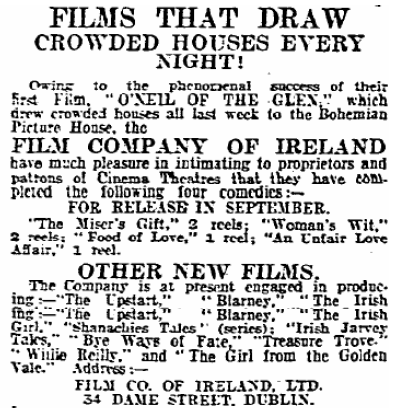
Irish Times 14 Aug. 1916: 4.
While O’Neil of the Glen toured the country, the company quickly followed up this successful debut with the announcements of their next films in the dailies and trades. On the Monday after the last show of O’Neil of the Glen at the Bohemian, the Dublin papers carried an advertisement headed “Films that Draw Crowded Houses Every Night!” that recommended FCOI’s new films on the basis of the audience-drawing power of that first film. Four two-reel comedies were scheduled for release in September – The Miser’s Gift, Woman’s Wit, Food of Love and An Unfair Love Affair – and nine other forthcoming productions were named, only one of which, “Willie Reilly,” is recognizable as a subsequent FCOI release. An Evening Mail reporter who attended The Miser’s Gift trade show at the Dame Street PH later that week commented that “[i]t is not only characteristically Irish, it is characteristically good. The Irish Picture-House manager who does not support an Irish company which can produce work of the class of ‘The Miser’s Gift’ is missing an opportunity of giving his shows a touch of distinction” (“‘Miser’s Gift’”).
The Miser’s Gift is also lost, but its narrative appears to involve a scheme of Eileen Dolan (Nora Clancy) and her lover, Ned McGrath (Fred O’Donovan), to get her miserly father (J. M. Kerrigan) drunk and dream of leprechaun gold so that he will look favourably on their relationship. “It is agreeable to have pictures such as this,’ commented the Irish Times, “preserving a genuinely Irish atmosphere and that inherent charm which is to be found in Irish life. The sight, for instance, of lepracauns and other little people who live in legend disporting themselves in a fairy fort is a feature which surely is pleasing to Irish eyes” (“Film Company of Ireland,” 18 Aug.). The Irish public got its first chance to delight in authentic Irish leprechauns disporting themselves on the cinema screen in October and November 1916: at Arklow’s Gaiety Picture House (9-11 October), Cork’s Coliseum (12-15 October), Tralee’s Picturedrome (19-21 October), Dublin’s Dame Street PH (26–8 October), Derry’s Hall (2-4 November), Sligo’s Picture Theatre (13-15 November), Kilkenny’s Cinema (15-16 November) and Athlone’s Fr Mathew Hall (22-25 Nov).
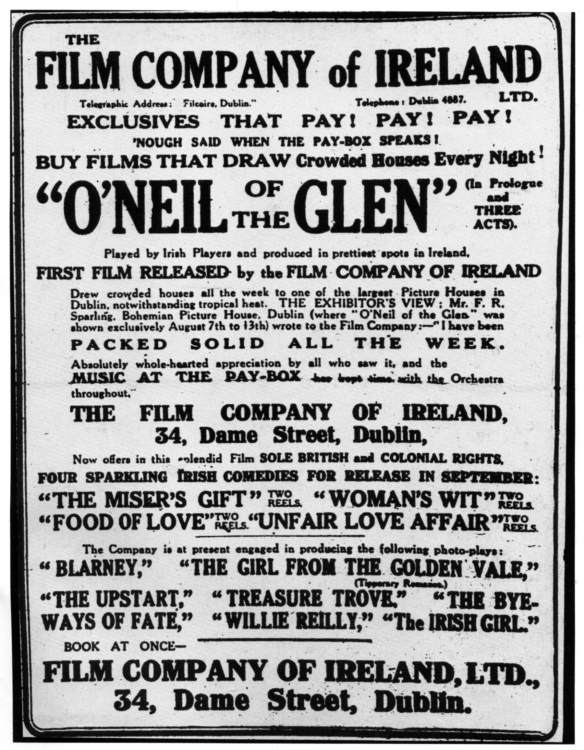
Bioscope 24 Aug. 1916: 754.
As these arrangements were being made for Ireland, FCOI also entered the British film market on the foundation of O’Neil of the Glen’s Irish success. The Bohemian debut was the subject of an article on the company in the Bioscope of 24 August, which also carried a full-page advertisement listing the actual and intended films mentioned in the Irish papers (“First Irish Film”). Both the article and the advertisement included quotes from Sparling on the huge business the film generated, “the absolutely whole-hearted appreciation of every person who has seen it,” and the fact that “the ‘music’ at the pay-box has kept time with the orchestra throughout.” In contrast to Paddy’s original critical assessment of the film, this article described the audiences’ appreciation of “the exceptional excellence of the first film produced in Ireland by an Irish company and by Irish players.” A month later, although mentioning the film’s success everywhere it had been exhibited, Paddy contended that FCOI’s “second picture, ‘The Miser’s Gift,’ is greatly in advance of the first as regards the quality, and if this company stick to their guns they should still be well in the front rank of British producers” (28 Sep.). Despite Paddy’s reservations, the message prevailed that O’Neil of the Glen packed cinemas in Dublin and Belfast and that Irish exhibitors were eager for more, a message that helped FCOI to acquire a British distributor (Paddy, 14 Sep.). The company did this at the end of October, when Davidson’s Film Sales Agency bought the rights for FCOI’s 1916 films (Paddy, 2 Nov.).
Indigenous Irish film production may not have started with O’Neil of the Glen, but it did enter a new phase.
References
“Abbey Theatre.” Irish Times 7 Aug. 1916: 3.
“The Bohemian.” Dublin Evening Mail 5 Aug. 1916: 5.
“The Bohemian.” Freeman’s Journal 8 Aug. 1916: 6.
“Coliseum Theatre: ‘O’Neill of the Glen.’” Cork Examiner 15 Sep. 1916: 2.
Condon, Denis. Early Irish Cinema, 1895-1921. Dublin: Irish Academic, 2008.
“The Film Company of Ireland.” Irish Times 9 Aug. 1916: 6; 18 Aug. 1916: 2.
“First Irish Film: Success of ‘O’Neil of the Glen.’” Bioscope 24 Aug. 1916: 689.
“The Hall.” Derry People 16 Sep. 1916: 5.
“Irish Film Production.” Irish Times 30 Jun. 1916: 7.
“Irish Film Triumph: Several New Plays.” Cork Examiner 16 Aug. 1916: 6.
“‘The Miser’s Gift’: New Irish Comedy.” Dublin Evening Mail 17 Aug. 1916: 2.
“New Irish Films: Four Coming Comedies.” Freeman’s Journal 15 Aug. 1916: 4.
“New Irish Industry: Film Company of Ireland.” Connaught Telegraph 5 Aug. 1916: 8.
“New Irish Industry: The Film Co. of Ireland: A Promising Enterprise.” Freeman’s Journal 30 Jun. 1916: 6.
“‘The O’Neill of the Glen.’” Derry People 12 Aug. 1916: 5.
Paddy. “Ireland: With the Renters and Exhibitors.” Bioscope 13 Jul. 1916: 173; 27 Jul. 1916: 359; 17 Aug. 1916: 655; 14 Sep. 1916: 1060; 28 Sep. 1916: 1285; 2 Nov. 1916: 518.
“Platform and Stage.” Irish Times 7 Oct. 1916: 9.
Rockett, Kevin. The Irish Filmography. Dublin: Red Mountain, 1996.
“Topics of the Week.” Bioscope 10 Aug. 1916: 466.
